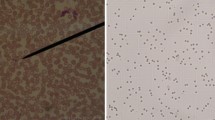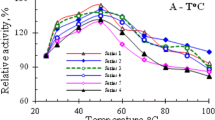Summary
The binding of direct lytic factor (DLF) from cobra venom (Naja naja) to intact guinea-pig red cells and to guinea-pig ghosts was estimated quantitatively by bioassay of DLF in the supernatant.
-
1.
DLF was not bound to intact red cells in considerable amounts, during 320 min incubation.
-
2.
The degree of binding to ghosts was much larger than that in suspensions of intact red cells. Binding to ghosts increased with time.
-
3.
Whereas the binding of DLF to ghosts was not much influenced by varying the incubation temperature, its haemolytic activity was completely absent at temperatures below 15°C.
By an immunofluorescence technique binding of DLF to erythrocytes was studied morphologically:
-
1.
DLF was only bound to red cell ghosts (guinea pig and rat), but not to intact red cells. This binding was not temperature dependent.
-
2.
Pretreatment of ghosts with SH-reagents such as NEM or PCMB did not prevent binding of DLF.
-
3.
Ghosts prepared by different methods (hypotonic shock, freezing and thawing, ultrasonication, and resealing) were all able to bind DLF to their surface.
It is concluded that the binding of small amounts of DLF to intact red cells, observed by bioassay, was due to the presence of a small fraction of lysed cells, and that the binding to ghosts is not related to the lytic effect of DLF but secondary to lysis.
Similar content being viewed by others
References
Brade, V., Vogt, W.: Immunization against cobra venom. Experientia (Basel) 27, 1338 (1971)
Condrea, E., de Vries, A., Mager, J.: Hemolysis and splitting of human erythrocyte phospholipids by snake venoms. Biochim. biophys. Acta (Amst.) 84, 60–73 (1964)
Condrea, E., Kendzersky, I., de Vries, A.: Binding of Ringhals venom DLF to erythrocytes and osmotic ghosts of various animal species. Experientia (Basel) 21, 461–462 (1965)
Dodge, J. T., Mitchell, C., Hanahan, D.: The preparation and chemical characteristics of hemoglobin free ghosts of human erythrocytes. Arch. Biochem. Biophys. 100, 119–130 (1963)
Lankisch, P. G., Lege, L., Oldigs, H. D., Vogt, W.: Binding of phospholipase A to the Direct Lytic Factor revealed by the interaction of Ca2+ with the haemolytic effect. Biochim. biophys. Acta (Amst.) 239, 267–272 (1971)
Schroeter, R., Lankisch, P. G., Lege, L., Vogt, W.: Possible implication of glutathione reductase in haemolysis by the Direct Lytic Factor of cobra venom (Naja naja). Naunyn-Schmiedeberg's Arch. Pharmacol. 275, 203–211 (1972)
Vogt, W., Patzer, P., Lege, L., Oldigs, H. D., Wille, G.: Synergism between phospholipase A and various peptides and SH-reagents in causing haemolysis. Naunyn-Schmiedebergs Arch. Pharmak. 265, 442–454 (1970)
Author information
Authors and Affiliations
Rights and permissions
About this article
Cite this article
Schroeter, R., Damerau, B. & Vogt, W. Differences in binding of the direct lytic factor (DLF) of cobra venom (Naja naja) to intact red cells and ghosts. Naunyn-Schmiedeberg's Arch. Pharmacol. 280, 201–207 (1973). https://doi.org/10.1007/BF00499181
Received:
Issue Date:
DOI: https://doi.org/10.1007/BF00499181




